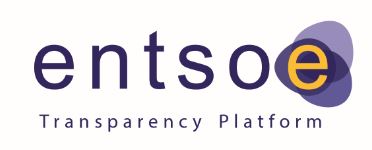
The ENTSO-E Transparency Platform
https://transparency.entsoe.eu
Central collection and publication of electricity generation, transportation and consumption data and information for the pan-European market.
What is the ENTSO-E Transparency Platform?
Transparency is a key element of an open and competitive European internal energy market; giving free and equal access to data and information for all market participants. The ENTSO-E Transparency Platform is a central point of collection and publication for this fundamental pan-European wholesale market data.
While many market players were already publishing data, it was not consistent across all Member States.
Regulation (EU) No 543/2013 on submission and publication of data in electricity markets was enacted to ensure that consistent pan-European data is available for all.
The European Network of Transmission System Operators for Electricity (ENTSO-E) was mandated to build the platform, which was launched on 5 January 2015.
What kind of data is on the platform?
New data is being continuously uploaded to the ENTSO-E Transparency Platform since early January. When complete, it will display around 6 million separate data values, arranged in the six major categories. Depending on the data item, the publication timeframes can range from 15 minutes through to yearly.
- Load: the amount of power being drawn from the system
- Generation: the amount of electricity produced, whether renewable, coal, gas-fired, nuclear etc…
- Transmission: the amount of bulk cross-border energy transferred throughout Europe
- Balancing: the amount of energy used to balance differences between supply and demand
- Outages: planned maintenance and unplanned failures of electricity generation, transmission and consumption units
- Congestion Management: data on actions taken to relieve overloaded sections of the European grid
Where does the data come from?
The data is collected from across the European energy sector, from what is known as primary data owners. These include generation companies, power exchanges, capacity allocation offices, transmission system operators, market balancing operators, distribution system operators and large consumption units. The data is then fed, configured and/or aggregated through a data provider, and submitted to the ENTSO-E Transparency Platform for publication.
The data journey

Click for more information about ENTSO-E
ENTSO-E press release on Transparency platform is available here.
At present Augstsprieguma tīkls AS also publishes the defined information according to EU Regulation (EC) No 714/2009 Annex1 paragraph 5 the European Parliament and of the council on conditions for access to the network for cross-border exchanges in electricity:
- TSOs shall publish all relevant data related to network availability, network access and network use, including a report on where and why congestion exists, the methods applied for managing the congestion and the plans for its future management.
- TSOs shall publish a general description of the congestion-management method applied under different circumstances for maximising the capacity available to the market, and a general scheme for the calculation of the interconnection capacity for the different timeframes, based upon the electrical and physical realities of the network. Such a scheme shall be subject to review by the regulatory authorities of the Member States concerned.
- The congestion management and capacity-allocation procedures in use, together with the times and procedures for applying for capacity, a description of the products offered and the obligations and rights of both the TSOs and the party obtaining the capacity, including the liabilities that accrue upon failure to honour obligations, shall be described in detail and made available in a transparent manner to all potential network users by TSOs.
- The operational and planning security standards shall form an integral part of the information that TSOs publish in an open and public document. That document shall also be subject to review of the national regulatory authorities.
